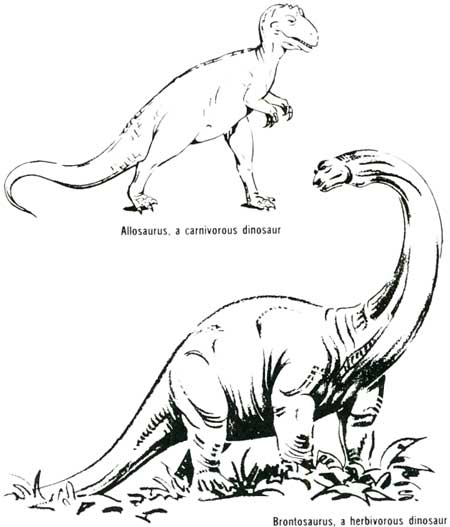|
Raising the Roof of the Rockies
A Geologic History of the Mountains and of the Ice Age in Rocky Mountain National Park |
The Era of Shifting Seas
From about 530 million years ago to perhaps 300 million years ago, central Colorado was invaded by relatively shallow inland seas which alternately spread across and receded from the region. Rocky Mountain National Park was probably covered by some of these seas, but not by others. None of their deposits remain in the Park today, but remnants of them have been found about 50 miles to the north, near Virginia Dale. They are well exposed at Manitou Springs in the canyon west of Colorado Springs, and elsewhere farther west in Colorado.
The deposits of the seas are mostly sandstone, limestone, and shale; and the life that roamed the seas included such creatures as trilobites, sharks, and fishes, as well as many varieties of shellfish such as clams, snails, and brachiopods. All the species living at that time are now extinct, but their shells or bones remain as fossils in the rocks of that era.

The Ancestral Rockies
About 300 million years ago the region of the present Front Range, including the Park, was uplifted from the seas. Immediately, streams began to erode away the previously deposited marine sediments. As the land rose higher, the streams cut through the sediments and deeply into the underlying older granite, gneiss, and schist. They stripped away all of the marine rocks, about 300 feet thick, and 2,000 to 3,000 feet of the older rocks. Eventually, a range of mountains, the Ancestral Rockies, was sculptured in the uplifted land mass. Though the total uplift of the land may have amounted to 4,000 to 5,000 feet, the pace of erosion was such that the mountains were never that high. Summits in the area of Rocky Mountain National Park were perhaps 2,000 feet above seas only about 100 miles distant to east and west. The debris carried from the mountains by the streams was spread on broad, gently sloping plains that fanned out to the seas. It was on these plains that air-breathing forms of life—amphibia—first developed in this region.


March of The Dunes
By about 240 million years ago the mountains had been reduced to low hills, and the plains to east and west were overrun by widespread coastal sand dunes which encroached over the land in front of an advancing shallow sea. It was at this time that reptiles first appeared. The dunes and sea ultimately spread across the region north of the Park, but probably did not cover the Park itself.
Then, about 190 million years ago, renewed uplift of the land caused the sea to recede again, and, following its shores, marched the coastal dunes. The dune sands and the deposits of the sea are now preserved as sedimentary rocks along the edges of the mountains east of the Park.

Dragons of The Flood Plains
Following the retreat of the dunes, broad tropical plains dotted with lakes and swamps spread out along major drainageways from low mountains in the area of the Park. This time was the middle of the Age of Reptiles when dinosaurs, both large and small, abounded. The deposits of these flood plains, now rocks, constitute the famous Morrison Formation in which so many large dinosaur skeletons, such as those in Dinosaur National Monument, have been found. The formation is named from the little town of Morrison, west of Denver, near which exposures of the formation in a deep highway cut are preserved as a special exhibit.

| <<< Previous | <<< Contents >>> | Next >>> |
richmond/sec2.htm
Last Updated: 8-May-2007